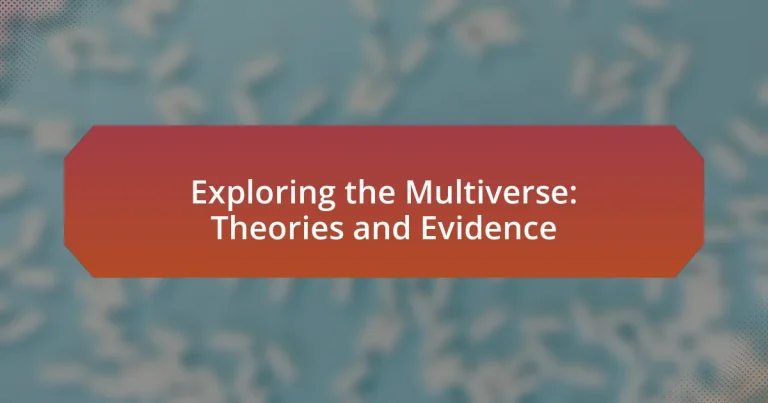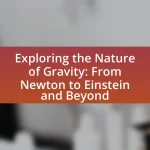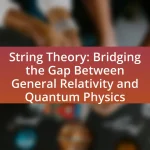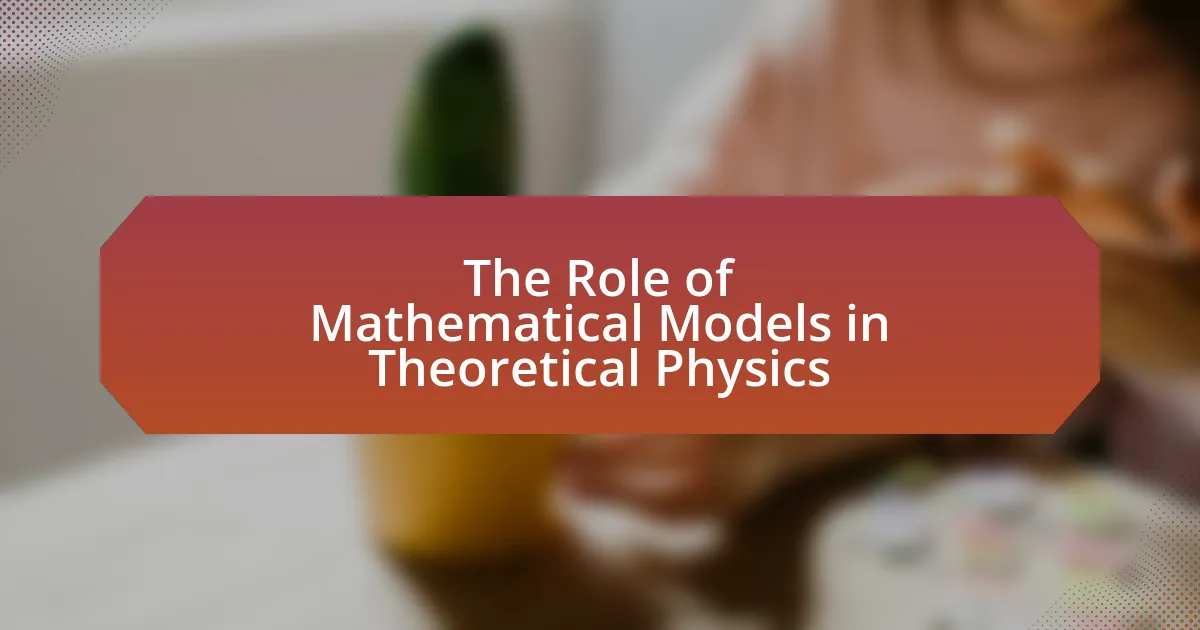The article “Exploring the Multiverse: Theories and Evidence” delves into the concept of the multiverse, a theoretical framework proposing the existence of multiple, potentially infinite universes beyond our own. It examines various theories that define the multiverse, including the quantum multiverse, cosmic inflation multiverse, string theory multiverse, mathematical multiverse, and anthropic multiverse, each offering unique perspectives on reality. The article also discusses the significance of the multiverse in modern physics, its implications for our understanding of existence, and the challenges it poses to traditional cosmology. Additionally, it addresses the evidence supporting the multiverse, criticisms of the theory, and future directions for research, highlighting the potential breakthroughs and technological advancements that may enhance our exploration of this complex topic.

What is the Multiverse?
The multiverse is a theoretical framework suggesting the existence of multiple, possibly infinite, universes beyond our own. This concept arises from various scientific theories, including quantum mechanics and cosmology, which propose that different universes can have different physical laws and constants. For instance, the inflationary model of the universe implies that during the rapid expansion after the Big Bang, regions of space could have stopped inflating at different times, leading to the formation of separate universes. Additionally, the many-worlds interpretation of quantum mechanics posits that every quantum event branches into different outcomes, creating parallel universes. These theories provide a basis for the multiverse concept, although empirical evidence remains elusive.
How do different theories define the Multiverse?
Different theories define the Multiverse as a collection of multiple, potentially infinite universes that exist parallel to each other. The cosmological multiverse theory, derived from inflationary cosmology, posits that different regions of space undergo inflation at different rates, leading to distinct universes with varying physical constants. The quantum multiverse, based on the many-worlds interpretation of quantum mechanics, suggests that every quantum event branches into multiple outcomes, creating separate realities. Additionally, string theory introduces the concept of a landscape of vacua, where different configurations of string theory yield diverse universes with unique properties. Each of these theories provides a framework for understanding the existence of multiple universes, supported by mathematical models and theoretical physics.
What are the key characteristics of each Multiverse theory?
The key characteristics of each Multiverse theory include the following:
-
Quantum Multiverse: This theory posits that every quantum event creates a branching of universes, leading to an infinite number of parallel realities. It is rooted in the many-worlds interpretation of quantum mechanics, which suggests that all possible outcomes of quantum measurements are realized in separate, non-communicating branches.
-
Cosmic Inflation Multiverse: This theory arises from the concept of cosmic inflation, where rapid expansion of space leads to the creation of bubble universes. Each bubble can have different physical constants and laws, resulting in a vast array of distinct universes.
-
String Theory Multiverse: String theory suggests that there are multiple dimensions beyond the familiar four, leading to a landscape of possible vacuum states. Each vacuum state corresponds to a different universe with its own set of physical laws, resulting in a multiverse of diverse realities.
-
Mathematical Multiverse: Proposed by Max Tegmark, this theory asserts that all mathematical structures exist physically. Thus, any universe that can be described mathematically is as real as our own, leading to an infinite variety of universes based on different mathematical frameworks.
-
Anthropic Multiverse: This theory focuses on the idea that our universe is one of many, and its specific conditions are a result of selection bias. The anthropic principle suggests that we observe our universe’s properties because they allow for the existence of observers, implying that other universes with different properties exist but are not conducive to life.
Each of these theories provides a unique perspective on the nature of reality and the existence of multiple universes, contributing to the broader understanding of the multiverse concept in modern physics.
How do these theories compare to traditional cosmology?
Theories exploring the multiverse differ from traditional cosmology primarily in their implications about the nature of reality. Traditional cosmology, based on the Big Bang model, posits a singular universe with a specific beginning and evolution, while multiverse theories suggest the existence of multiple, potentially infinite universes, each with its own distinct laws of physics. For instance, the inflationary multiverse theory, proposed by cosmologist Alan Guth, indicates that different regions of space can undergo inflation at different rates, leading to diverse universes. This contrasts with traditional cosmology’s focus on a singular, observable universe governed by uniform laws. The multiverse concept challenges the notion of a unique cosmic history and raises questions about the fine-tuning of physical constants, suggesting that our universe is just one of many possible configurations.
Why is the concept of the Multiverse significant in modern physics?
The concept of the Multiverse is significant in modern physics because it provides a framework for understanding the fundamental nature of reality and the origins of our universe. This idea suggests that our universe is just one of many, potentially infinite, universes that exist simultaneously, each with its own distinct laws of physics and constants. The significance is underscored by theories such as cosmic inflation, which implies that different regions of space can evolve into separate universes, and string theory, which allows for multiple dimensions and configurations. These theories offer explanations for phenomena that are difficult to account for within a single-universe model, such as the fine-tuning of physical constants necessary for life.
What implications does the Multiverse have for our understanding of reality?
The Multiverse suggests that our reality is just one of many possible universes, fundamentally altering our understanding of existence. This concept implies that the laws of physics, constants, and initial conditions can vary across different universes, leading to diverse forms of matter and life. For instance, the Many-Worlds Interpretation of quantum mechanics posits that every quantum event branches into multiple outcomes, creating parallel realities. This challenges the notion of a singular, objective reality and raises questions about determinism and free will. Furthermore, the idea of an infinite number of universes allows for the possibility of alternate histories and futures, expanding the scope of scientific inquiry and philosophical debate regarding the nature of existence and our place within it.
How does the Multiverse challenge existing scientific paradigms?
The Multiverse challenges existing scientific paradigms by proposing that our universe is just one of many, fundamentally altering the understanding of reality. This concept contradicts the traditional view of a singular, observable universe governed by consistent physical laws, as it suggests the existence of multiple universes with potentially different laws of physics. Theoretical frameworks, such as string theory and cosmic inflation, support the Multiverse idea, indicating that variations in fundamental constants could lead to diverse universes. Empirical evidence remains elusive, but the implications of the Multiverse provoke significant debate regarding the nature of scientific inquiry, testability, and the limits of human understanding in cosmology.

What evidence supports the existence of the Multiverse?
The existence of the Multiverse is supported by several theoretical frameworks and indirect evidence. One significant piece of evidence comes from cosmic inflation theory, which suggests that rapid expansion of the universe could lead to the creation of multiple, separate universes. This theory is backed by observations of the cosmic microwave background radiation, which shows uniformity that aligns with inflationary models. Additionally, string theory posits the existence of multiple dimensions and universes, providing a mathematical framework that supports the Multiverse concept. Furthermore, the anthropic principle suggests that the physical constants of our universe are fine-tuned for life, implying that other universes with different constants could exist. These theoretical foundations and observations collectively lend credence to the Multiverse hypothesis.
What observational data suggests a Multiverse?
Observational data suggesting a Multiverse includes the cosmic microwave background radiation (CMB) anomalies and the distribution of galaxies. The CMB, which is the afterglow of the Big Bang, exhibits fluctuations that some researchers argue could indicate interactions with other universes. Additionally, the large-scale structure of the universe, including the unexpected distribution of galaxies, may imply the existence of other universes influencing our own. These observations align with theories such as inflationary cosmology, which posits that rapid expansion could lead to multiple, disconnected regions of space-time, each potentially forming its own universe.
How do cosmic microwave background radiation studies relate to the Multiverse?
Cosmic microwave background radiation studies provide evidence that supports the Multiverse theory by revealing anomalies that suggest the existence of other universes. The Cosmic Microwave Background (CMB) is the afterglow of the Big Bang, and its uniformity and slight fluctuations can indicate the influence of other universes on our own. For instance, certain patterns in the CMB, such as cold spots, may be attributed to gravitational effects from neighboring universes, as proposed in theories like eternal inflation. This connection is reinforced by research published in the journal “Physical Review Letters,” which discusses how these anomalies can be interpreted within the framework of the Multiverse, suggesting that our universe is just one of many.
What role do quantum mechanics and string theory play in providing evidence?
Quantum mechanics and string theory play crucial roles in providing evidence for the multiverse concept by offering frameworks that suggest the existence of multiple universes. Quantum mechanics introduces the idea of superposition and entanglement, which imply that particles can exist in multiple states simultaneously, leading to interpretations like the Many-Worlds Interpretation, where every quantum event spawns a new universe. String theory, on the other hand, posits that fundamental particles are one-dimensional strings rather than point-like objects, allowing for a vast landscape of possible universes with different physical laws and constants. This theoretical framework is supported by mathematical models that predict various configurations of these strings, suggesting a multiverse where different regions of space can have distinct properties.
What are the criticisms of the evidence for the Multiverse?
Critics argue that the evidence for the Multiverse is largely speculative and lacks empirical support. The primary criticism is that the Multiverse theory does not make testable predictions, which is a fundamental requirement for scientific validation. Additionally, some scientists contend that the theory is unfalsifiable, meaning it cannot be proven wrong, which undermines its scientific credibility. Furthermore, critics highlight that the reliance on inflationary cosmology to support the Multiverse is problematic, as inflation itself is still a debated concept within cosmology. These criticisms emphasize the need for more rigorous evidence and testable hypotheses to substantiate the Multiverse theory.
How do skeptics argue against the Multiverse theories?
Skeptics argue against Multiverse theories primarily due to the lack of empirical evidence supporting the existence of multiple universes. They contend that these theories often rely on speculative mathematics rather than observable phenomena, making them scientifically unfalsifiable. For instance, physicist Sean Carroll has noted that many Multiverse models do not produce testable predictions, which undermines their scientific validity. Additionally, skeptics highlight that the Multiverse concept can lead to an infinite regression of universes, complicating the understanding of our own universe without providing concrete explanations for its properties. This reliance on untestable hypotheses raises concerns about the scientific rigor of Multiverse theories.
What alternative explanations exist for the observed phenomena?
Alternative explanations for the observed phenomena in the context of the multiverse theory include the possibility of a single universe with varying physical laws, the simulation hypothesis, and the anthropic principle. The single universe model suggests that what appears to be multiple universes could be variations within one universe governed by different physical constants. The simulation hypothesis posits that our perceived reality is a computer-generated simulation, which could account for anomalies in observed phenomena. The anthropic principle argues that the universe’s physical laws are as they are because they allow for the existence of observers; thus, the observed phenomena are a result of selection bias rather than multiple universes. These explanations challenge the multiverse theory by providing alternative frameworks to interpret the same data.

How do we explore the Multiverse conceptually and experimentally?
We explore the Multiverse conceptually through theoretical frameworks such as string theory and cosmic inflation, which suggest the existence of multiple universes with varying physical laws. Experimental exploration occurs via indirect evidence, such as cosmic microwave background radiation measurements and the study of quantum fluctuations, which may indicate the presence of other universes. For instance, the Planck satellite data provides insights into the early universe’s conditions, supporting inflationary models that imply a multiverse scenario.
What methods are used to investigate Multiverse theories?
Methods used to investigate Multiverse theories include mathematical modeling, observational astronomy, and theoretical physics. Mathematical modeling allows researchers to create frameworks that describe the properties and behaviors of multiple universes, often using complex equations derived from quantum mechanics and cosmology. Observational astronomy involves examining cosmic phenomena, such as cosmic microwave background radiation, to find indirect evidence of other universes. Theoretical physics employs concepts from string theory and inflationary cosmology to propose mechanisms for the existence of a multiverse, providing a basis for further exploration and validation of these theories.
How do simulations and mathematical models contribute to our understanding?
Simulations and mathematical models enhance our understanding by allowing researchers to visualize complex systems and predict outcomes based on theoretical frameworks. For instance, in the context of the multiverse, simulations can model various scenarios of cosmic inflation and the formation of multiple universes, providing insights into their properties and behaviors. A notable example is the work by Andrei Linde, who developed inflationary models that predict the existence of a multiverse, supported by simulations that illustrate how different inflationary scenarios lead to diverse universe characteristics. These models and simulations serve as critical tools for testing hypotheses and refining theories in cosmology, ultimately deepening our comprehension of the universe’s structure and origins.
What experimental approaches are being considered to test Multiverse hypotheses?
Experimental approaches being considered to test Multiverse hypotheses include cosmic microwave background (CMB) observations, gravitational wave detection, and high-energy particle physics experiments. CMB observations aim to identify anomalies or patterns that could indicate interactions with other universes, as suggested by theories like inflation. Gravitational wave detection, particularly from events like black hole mergers, may reveal signatures of extra dimensions or parallel universes. High-energy particle physics experiments, such as those conducted at the Large Hadron Collider, seek to uncover evidence of additional dimensions or particles that could support the existence of a multiverse. These approaches are grounded in theoretical frameworks that predict observable consequences of multiverse scenarios, making them valid avenues for exploration.
What are the future directions for Multiverse research?
Future directions for Multiverse research include the development of more precise theoretical models and the integration of observational data from advanced telescopes. Researchers aim to explore the implications of string theory and quantum mechanics on the multiverse concept, potentially leading to testable predictions. Additionally, interdisciplinary approaches combining cosmology, particle physics, and philosophy are being pursued to deepen the understanding of multiverse scenarios. Recent advancements in cosmic microwave background radiation studies may provide empirical evidence supporting or refuting multiverse theories, guiding future investigations.
How might advancements in technology impact our exploration of the Multiverse?
Advancements in technology will significantly enhance our exploration of the Multiverse by providing more sophisticated tools for observation and analysis. For instance, improvements in quantum computing could enable simulations of complex multiverse models, allowing scientists to test theories that were previously computationally infeasible. Additionally, advancements in telescope technology, such as the development of space-based observatories with higher resolution and sensitivity, will facilitate the detection of cosmic phenomena that may indicate the existence of other universes. These technological innovations are crucial, as they can lead to new insights and empirical evidence supporting or refuting multiverse theories, thereby advancing our understanding of fundamental physics.
What are the potential breakthroughs we can expect in the coming years?
In the coming years, we can expect significant breakthroughs in the understanding of the multiverse, particularly through advancements in quantum physics and cosmology. Research from institutions like the European Organization for Nuclear Research (CERN) and the Hubble Space Telescope has indicated that new observational data may provide insights into parallel universes and the fundamental nature of reality. For instance, the detection of gravitational waves and cosmic microwave background radiation is expected to enhance our understanding of the universe’s structure and its potential multiverse implications. These advancements could lead to a more comprehensive theoretical framework that integrates quantum mechanics with general relativity, potentially validating multiverse theories.
What practical implications does the Multiverse have for our understanding of existence?
The Multiverse theory suggests that our universe is one of many, which has significant implications for our understanding of existence. This concept challenges the uniqueness of our universe, implying that different physical laws and constants could exist in other universes, leading to diverse forms of life and reality. For instance, the idea that there could be universes where the fundamental constants of physics differ from our own raises questions about the nature of reality and existence itself. Research in cosmology, such as the work by Andrei Linde on inflationary cosmology, supports the notion of a multiverse, indicating that quantum fluctuations during the early universe could lead to the creation of multiple, distinct universes. This understanding can reshape philosophical discussions about existence, identity, and the nature of reality, suggesting that our universe is just one of many possible realities.




